The COVID-19 disease is one of the most serious epidemic outbreaks in modern history. Unless drastic measures are taken, by governments, organisations and individuals, it is going to be a global pandemic with serious consequences on people, economy and societies around the world.
COVID-19 spreads fast. Importantly, not all carriers develop symptoms, thus the actual infection rate is underestimated. So far, the death rate seems to be around 3.4% of those diagnosed with the disease. With an incubation period between 1 and 14 days, the virus can survive on surfaces for several days. These numbers suggest that preventing the spread of the disease is very difficult. Specialists are estimating that 20%-60% of the global population could get infected with virus over the next two years. In numbers between 1.560,000,000 and 4,680,000,000 human being, and a sub-group of those will develop symptoms, and will need some form of medical attention.
Mortality rate seems to be higher among older individuals, and individuals with respiratory diseases or diabetes. The graph below presents the proportion of deaths among confirmed cases and it shows an increased risk for older patients, and for those already suffering from cardiovascular, diabetes and respiratory diseases and hypertension. The original data can be found in this report.
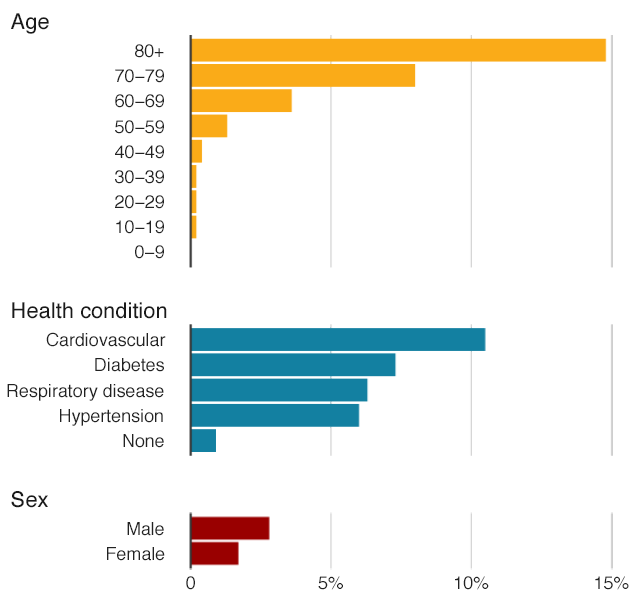
The numbers from China, suggest that the spread of the virus is slowing down, nonetheless in Europe, the US and in other countries around the world the number show exponential growth.
The following image shows a screenshot from the Dashboard of the Coronavirus COVID-19 Global Cases by John Hopkins CSSE. On the left panel it shows the total number of global infections to date, and a national breakdown sorted by most affected (in red). The right panel shows the number of total recoveries (in green), the number of mortalities is shown in white. A map of the world shows location where the virus has been reported. the size of the red circle is promotional to the number of diagnosed cases. In the bottom right, the time line shows the evolution of number of diagnosis in Mainland China and else where in the world as well as the total number of recoveries. The Dashboard is interactive and has several useful features.
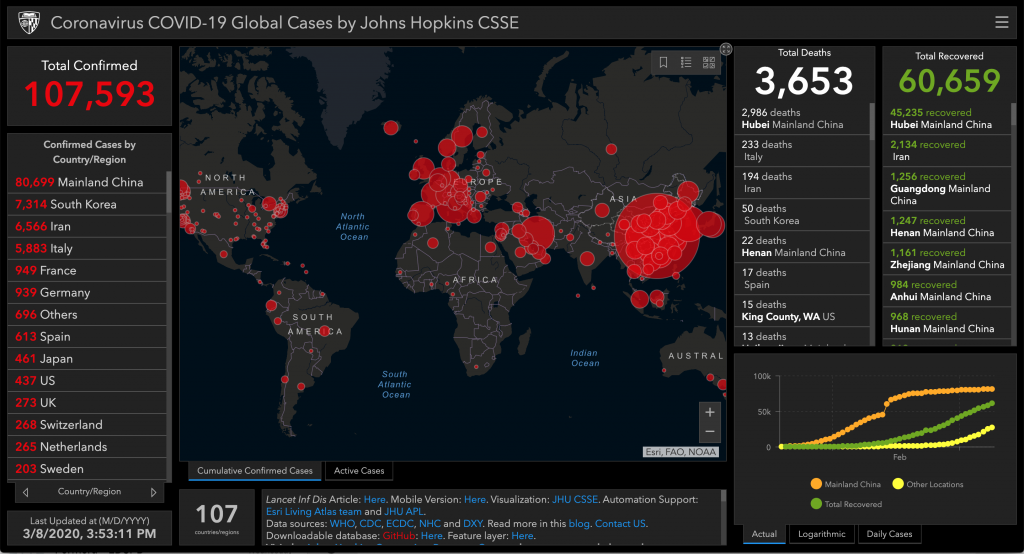
In worst case scenario, the comparable pandemic could be the Spanish Flu of 1918-1920 during which between 50,000,000 and 100,000,000 died as a result of the outbreak, and many more were severely sick for weeks, with crushing effect on communities around the world. Actually the economical damage is already happening, although we are at an early stages of the outbreak.
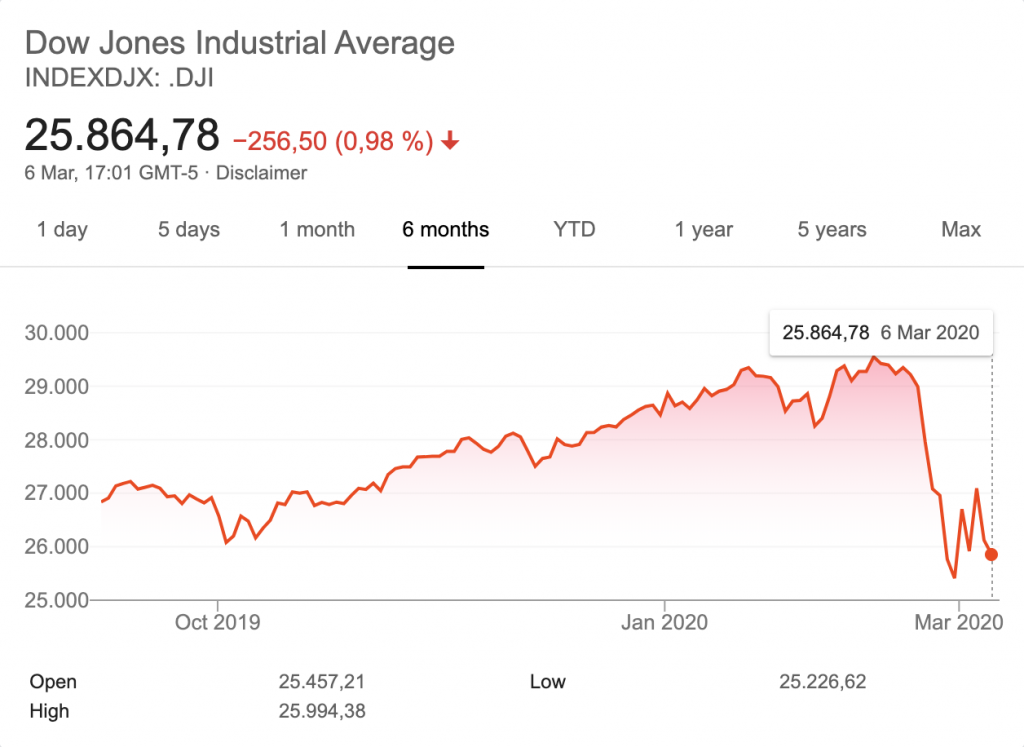
The Good News
The good news is that we no longer live in the 1900s, and this is not the Spanish flu where infants and younger people were at risk. Antibiotics have not been invented yet and health systems were in much poorer condition in comparison to now.
Modern communications and the Internet are allowing for near real-time update of the epidemic around the globe. The World Health Organisation WHO and other International Organisations are making a great difference in coordinating multinational action and smoothing difficulties and shortages here and there.
Governments around the world are showing a great deal of responsible behaviour and are making unpopular decisions, such as closing borders, landing flights, quarantining towns and cities, closing schools. Many companies are asking people to work from home. International conferences concerts and festivals are postponed or cancelled. For example 12 Millions people were Quarantined in Northern Italy the 08.03.2020 as the map below shows:
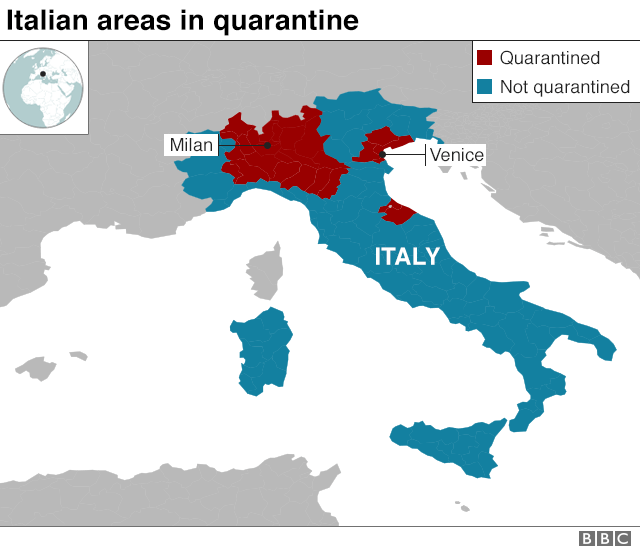
Pharmaceutical companies and laboratories around the world are scrambling to create a cure or a vaccine for SARS-CoV-2. Besides the social value of a cure, there is big money to be made here. Within few days of the outbreak, labs around the world received samples of the virus. Some companies are trying to develop vaccines using a new genetics based technology.
If preventing the wide-spread of the virus was not possible, and a global pandemic was unavoidable, then slowing it would be the next best strategy. All efforts made by responsible government feeds into this goal. Slowing the spread can allow enough time for hospitals, local governments, and communities to prepare for it. It also allows more time for a vaccine to be developed before too much damage has been made. Slowing down the pandemic will also reduce the risk of the virus mutating into something worse.
What Can We Do?
The rest of the work falls on all of us. It is actually possible, if we all take COVID-19 seriously, to collectively avoid the catastrophe or limit it. It all take few measures to protect ourselves and others around us from catching this (and other similar viruses) or spreading it:
- Wash your hands more often
- Do not touch your face
- Clean and disinfect surfaces
- Limit physical contact with others
- Avoid gatherings
- Do Home-office whenever possible
- Self-quarantine when feeling sick
- Go to a capable hospital if you have symptoms.
For more information, check this page the WHO have created especially to give advise to the public on all things related to COVID-19
By adhering to these rules we, could stop the pandemic or at least slow it down. The short video below shows a computer simulation of a flu virus outbreak in the UK from the Documentary Contagion: The BBC Four Pandemic, comparing the case of normal and extra washing of hands. The simulation shows the infection spreads much slower in case of extra washing of the hands than in the normal case.
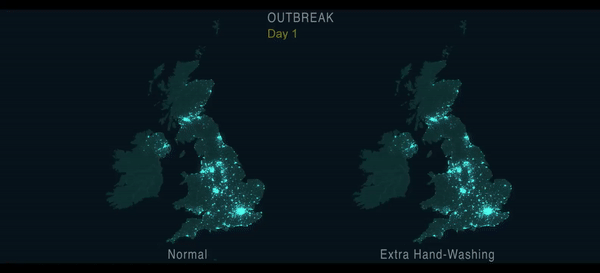
Concluding Remarks
Unlike the past, advances in science, technology and medicine are allowing us to take matter into our own hands to tackle a challenge on a global level. Government and many organisations are listening to epidemiologists, virologists, and medical doctors working on this subject. The big social experiment is whether the general public will also listen to scientists and take their advise and warning seriously.
References:
WHO – COVID-19 – Situation Report – 46 – 06.03.2020 (PDF)
WHO – COVID-19 – Q&A – (web – accessed on 08.03.2020)
WHO – COVID-19 – Advise for the public – (web – accessed on 08.03.2020)
Worldmeters.info Expert Opinions on COVID-19 (web – last accessed on 08.03.2020)
CBSNews – Coronavirus may infect up to 70% of world’s population, expert warns – 02.03.2020 (web – last accessed on 08.03.2020)
CCDC – The Epidemiological Characteristics of an Outbreak – Novel Coronavirus Diseases COVID-19 – China, 2020 – (PDF)
John Hopkins – Coronavirus COVID-19 Global Cases Dashboard
Wikipedia – The Spanish Flu
Wikipedia – COVID-19 Fälle in Deutschland (web – accessed 08.03.2020)
BBC – Contagion: The BBC Four Pandemic
BBC – Coronavirus: Northern Italy quarantines 16 million people
The impact of the 1918 Spanish Flu Epidemic on Economic Performance in Sweden (PDF)
Marketwatch.com Companies working on Coronavirus treatment or vaccines (web – 06.03.2020)
Ourworldindata.org The Spanish flu (1918-20): The global impact of the largest influenza pandemic in history (web – accessed 08.03.2020)
Liveuamap.com – News of deceases and epidemics on live map – (web – accessed 08.03.2020)
The featured image is credited to NIAID and is under Creative Commons Attribution 2.0 Generic License.
